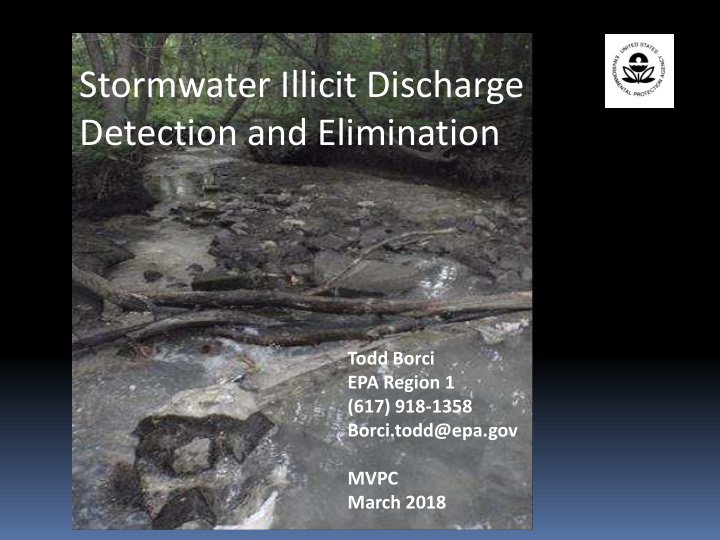



Stormwater Illicit Discharge Detection and Elimination Todd Borci EPA Region 1 (617) 918-1358 Borci.todd@epa.gov MVPC March 2018
Boston Harbor Cleanup – Since 2005, EPA enforcement of IDDE has resulted in excess of 185,000 gallons of sewage per day removed from stormwater outfalls (over 67 MG/year)
Investigations in the Boston Harbor watershed alone have resulted in 15 Administrative Orders and Four Consent Decrees that include IDDE since 2005 – this number will increase.
Illicit Discharges ▪ Most often sanitary sewage entering a municipal stormwater system ▪ Either through aging infrastructure or incorrectly-plumbed connections ▪ A significant source of pollutants ▪ Sewer Problems (often) = Illicit Discharges ▪ Identify through a weight-of-evidence approach (EPA R1 uses bacteria, surfactants, ammonia, and selected pharmaceutical compounds)
The “Raccoon Defense” . . .
The “Raccoon Defense” . . .
An Attempt at a Solution . . . Forensic Methods Screening Methods Bacterial Water Quality
Project Overview ▪ EPA Regional Applied Research Effort (RARE) and Regional Methods (RM) funding ▪ Identify most effective and cost- efficient screening parameters ▪ Determine feasibility of using pharmaceutical compounds ▪ Sampling conducted throughout eastern New England
Analytes tested for… ▪ ▪ E. coli Potassium • Commercial lab ▪ Enterococcus • Test kit – Hannna ▪ Fecal Coliform ▪ Fluoride ▪ Ammonia • Commercial lab • Commercial lab • Benchtop (DR-850 Hach) • Benchtop (DR-850 Hach) ▪ Pharmaceuticals • Test kit – Hach (2 types) • Atenolol • Test strips • Acetaminophen ▪ Nitrate/Nitrite • Cotinine ▪ Surfactants • 1,7-Dimethylxanthine • Commercial lab • Caffeine • Benchtop (DR-850 Hach) • Azithromycin • Test kit – Chemetrics • Primidone • Urobilin ▪ Free and Total Chlorine • Carbamazepine • Commercial lab • Sulfamethazine • Test kit – Hach • Sulfamethoxazole • Test strips ▪ Urine test strips ▪ Total Phosphorus
Sample Collection Summary ▪ 335 sample sets collected at nearly 250 sites ▪ In excess of 3,650 laboratory samples ▪ In excess of 2,000 field kit analyses ➢ 80% did not meet bacterial Water Quality Standards
Sample Collection Summary Using Field Kit Thresholds of 0.5 mg/l Ammonia and 0.25 mg/l Surfactants: 62% exceeded either the ammonia or surfactant threshold values; 24% exceeded both ammonia and surfactant threshold values;
Mill Brook - Arlington, MA Site name: 91Mys Surf NH 3 E.coli Date Site mg/L mg/L MPN 91Mys* 6/2/09 >241,960 1.25 3 Dry MillB* 6/2/09 550 0.2 ND Dry Site name: MillB
Recommended Minimum Screening Tests Bacteria test E. coli or Enterococcus Ammonia test strips Surfactant test kit Chlorine (total) test kit https://www3.epa.gov/region1/npdes/stormwater/ma/epa-ne-bacterial-source-tracking- protocol.pdf
EPA Modified Method 1694 LC/MS/MS Target Compounds, Uses, and Reporting Limits Target Major Use RL Daily Dose Compound (ng/L) (ng) Caffeine Natural Stimulant 5.0 200,000,000 1,7-DMX Metabolite of caffeine 2.5 N/A Acetaminophen Pain Reliever 2.5 650,000,000 Carbamazepine Anti- depressant / bi-polar 0.5 400,000,000 Anti-convulsant (epilepsy) Metoprolol High Blood Pressure 2.0 100,000,000 Atenolol Beta Blocker 2.0 50,000,000 High Blood Pressure Metabolite of Nicotine 0.5 3,500-7,200 Cotinine (ng/mL)
Spot Pond Brook, Stoneham, MA Analyte Result E. coli (MPN) 21 Surfactants ND Ammonia ND Caffeine 9.9 ng/L 1,7- 7 ng/L Dimethylzanthine Urobilin ND (2.0 ng/L) Cotinine ND (0.2 ng/L) Acetaminophen ND (1.0 ng/L) Carbamazepine ND (0.2 ng/L) Atenolol ND (2.0 ng/L) Azithromycin ND (2.0 ng/L) Primidone ND (2.0 ng/L)
Boston, MA Analyte Result E. coli (MPN) 198,630 Enterococcus 34,658 Surfactants 1.5 mg/L Ammonia 5.5 mg/L Caffeine 5,000 ng/L 1,7-Dimethylzanthine 3,500 ng/L Urobilin 17,000 ng/L Cotinine 13 ng/L Acetaminophen 27,000 ng/L Carbamazepine 5.1 ng/L Atenolol 150 ng/L Azithromycin 61 ng/L Primidone ND (2.0 ng/L) Canterbury Brook
Laconia, NH Analyte Result E. coli (MPN) 17,200 Enterococcus 26,030 Surfactants 0.2 mg/L Ammonia ND Caffeine 12 ng/L 1,7- 12 ng/L Dimethylzanthine Urobilin ND (4.0 ng/L) Cotinine ND (0.4 ng/L) Acetaminophen ND (2.0 ng/L) Carbamazepine ND (0.4 ng/L) Atenolol ND (2.0 ng/L) Azithromycin ND (2.0 ng/L) Primidone ND (4.0 ng/L) Human or Goose?
Conclusion - Most likely problem areas: ▪ Dense urban areas with aging infrastructure; ▪ Current or past sanitary sewer problems (SSOs); ▪ Areas with high sanitary sewer Inflow/Infiltration; ▪ Areas with state or watershed association data indicating water quality problems; ▪ Beaches with MS4 outfalls discharging onto or nearby.
A Successful Program . . . ▪ Knows its system: ▪ Maps match up with what is in the field ▪ Which outfalls have dry-weather flow ▪ Collects analytical data – screening or otherwise ▪ Understands illicit discharges and sanitary sewer issues often connected ▪ Tracks progress: ▪ Number of illicit discharges identified ▪ Number of illicit discharges removed ▪ Gallons per day of sewage removed from storm drain system ▪ Linear feet piping CCTV’d ▪ Linear feet piping smoke tested ▪ Linear feet of CIPP lining
Recommended Approach ▪ Bacteria analyses in addition to surfactant, ammonia, and chlorine field kits Forensic Methods ▪ End-of-pipe or within drain network sampling Screening Methods ▪ Enable watershed associations, municipalities, State and Federal personnel to collect more useful data Bacterial Water Quality ▪ Use pharmaceuticals as appropriate in confirmatory, problem solving, enforcement
Additional Contact Information Todd Borci Enforcement Officer EPA Region 1 (617) 918-1358 Borci.todd@epa.gov
Outfall Observations Salem, MA: NorRO1P Boston, MA: NR204
Outfall Observations Medford, MA: MHB Chelsea, MA: Mill2
Outfall Observations Dorchester, MA: CantB Concord, NH: Mer4120
Arlington, MA Grove Street Outfalls on Mill Brook - Sewage-impacted flows not always apparent During visual inspection
Recommend
More recommend